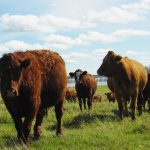CHICAGO, Illinois -American cattle producers are more interested in the current profitable situation than in rebuilding the herd, and the result is a record amount of cattle going to feedlots.
“The industry is definitely going toward selling cattle in the short term rather than building replacement herds,” said Dan Vaught, livestock analyst with AG Edwards. “What it boils down to is these guys (ranchers and backgrounders) are taking the money and running.”
On July 20 the United States Department of Agriculture released its semi-annual cattle inventory report and monthly cattle-on-feed report for the seven major feeding states.
Read Also

European wheat production makes big recovery
EU crop prospects are vastly improved, which could mean fewer canola and durum imports from Canada.
USDA reported the July 1 feedlot supply in the seven major feedlot states was 106 percent of a year ago, or 9.466 million head, which was near the high end of trade estimates, and the 28th consecutive month of record on-feed supplies. It also reported June placements at 120 percent of a year ago, or 1.690 million head, which also exceeded trade estimates and was a record for the month.
The U.S. as of July 1 had 105.8 million head of cattle, down from 106.3 million last year, and close to the average early estimate of 105.7 million head. But the inventory report showed there is no expansion of the cattle breeding herd, and some breeding stock continues to be pointed toward the feedlots, due to the lucrative feeder prices.
Analysts all cited the weight breakdown in the cattle-on-feed report, which showed that all weight categories were larger than a year ago. These numbers showed the industry is not interested in holding back cattle for expansion but wants to sell cattle to feedyards.
“The heifers are still being directed into the feedlots. The money for the feeder cattle is too lucrative for the industry to start holding back the heifers at this point,” said Chuck Levitt, an analyst with Alaron Trading Corp.
The inventory report had other heifers at 101 percent of last year, at 8.2 million head, and heifers being held back for beef cow replacement at 98 percent, or 4.6 million head.
“I think it is a negative (on-feed) report, and I think it puts into serious question whether the summer cash lows are in place and whether the summer lows are in the futures market,” said Dennis Smith, broker with the Linn Group.
Smith said the marketing number, along with the recent firmer cash news, may be supportive to August live cattle futures. But he expects packers to become less aggressive for fed cattle based on the large feedlot supplies.
Dale Benson, livestock analyst at Crystal River Capital, said: “We have had very aggressive placements on expectations for cattle in the future to make money.”
Benson questioned the quality of the feeder cattle since recent high prices may have drawn lower quality cattle that otherwise would have stayed on pastures.
But the better-than-expected marketings pace may not be big enough to offset the expected pressure from rising feedlot supplies.
Marketings were active because there was one less marketing day in June versus last year, and the number of cattle sold is down only one percent.
But Levitt added, “Even though marketings pace was a little better than we thought, it really did not change the front end supply. We still have a 21 percent increase in the front end supply vs. last year, and 50 percent relative to the five year average, which means we still have plenty of cattle to deal with in the coming months.”















